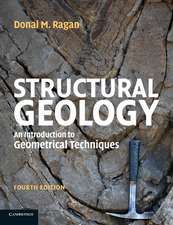Emplacement Mechanisms of Nappes and Thrust Sheets: Petrology and Structural Geology, cartea 9
Autor Olivier Merleen Limba Engleză Hardback – 30 oct 1998
Preț: 684.26 lei
Preț vechi: 900.34 lei
-24% Nou
Puncte Express: 1026
Preț estimativ în valută:
130.93€ • 137.05$ • 108.98£
130.93€ • 137.05$ • 108.98£
Carte tipărită la comandă
Livrare economică 26 martie-01 aprilie
Preluare comenzi: 021 569.72.76
Specificații
ISBN-13: 9780792348795
ISBN-10: 0792348796
Pagini: 160
Ilustrații: 1
Dimensiuni: 156 x 234 x 11 mm
Greutate: 0.43 kg
Ediția:1998
Editura: SPRINGER NETHERLANDS
Colecția Springer
Seria Petrology and Structural Geology
Locul publicării:Dordrecht, Netherlands
ISBN-10: 0792348796
Pagini: 160
Ilustrații: 1
Dimensiuni: 156 x 234 x 11 mm
Greutate: 0.43 kg
Ediția:1998
Editura: SPRINGER NETHERLANDS
Colecția Springer
Seria Petrology and Structural Geology
Locul publicării:Dordrecht, Netherlands
Public țintă
ResearchDescriere
Nappes
and
overthrusts
are
the
mosl
representative
geological
structures
in
mountain
chains.
The
issue
of
their
emplacement
mechanisms
and
of
the
driving
force
of
these
displacements
is
a
major
problem
in
tectonics
which
interests,
for
near
to
a
century
now
and
not
without
harsh
controversies,
a
significant
proportion
of
structural
geologists
and
geoscientists
who
work
in
the
field
of
rock
mechanics.
This
book
attempts
to
give
a
clear
and
didactic
synthesis
of
the
current
knowledge
of
the
concept
of
thrusting,
principally
by
tackling
two
approaches,
mechanics
and
kinematics,
which
have
proposed
some
solutions
to
this
problem.
At
first
(Chapter
I),
the
notions
of
thrusting
are
defined,
with
the
most
recent
terminology
and
the
most
important
geometric
aspects.
This
introduction
to
the
geometry
of
thrusts
is
logically
followed
by
the
presentation
of
their
problem;
the
issue
of
the
emplacement
mechanisms
(Chapter
2).
Let
us
note
in
passing
that
the
formulation
of
the
concept
and
the
presentation
of
its
problem
are
associated
historically,
which
justifies
presenting
them
in
the
historical
framework
of
this
discovery
before
tackling
the
different
solutions
and
mechanical
hypotheses.
These
are
detailed
in
Chapter
3
by
following
a
chronological
progression,
and
emphasising
the
divergences
and
oppositions
between
different
models
so
as
to
cover
them
fully.
The
chapter
on
the
kinematics
(Chapter
4)
then
returns
to
the
type
of
data
which
can
be
collected
in
the
field,
by
clarifying
the
relationships
between
displacement
and
internal
strain.
Cuprins
Preface.
1:
The
Concept
of
Thrusting.
1.1.
Nappes,
Thrusts
and
Fold-Nappes.
1.2.
Thick
and
Thin-Skinned
Thrusting.
1.3.
Ramp
and
Flat
Geometry.
1.4.
The
Concept
of
Displacement.
1.5.
The
Measurement
of
Displacement.
2:
Background.
2.1.
Historical
Overview
of
the
Discovery
of
Nappes.
2.2.
The
Problem
of
Nappe
Emplacement.
3:
Mechanics.
3.1.
The
Mechanical
Paradox.
3.2.
Resolution
of
the
Mechanical
Paradox.
3.3.
Composite
Models.
3.4.
The
Role
of
Erosion.
3.5.
Classification
of
Emplacement
Mechanisms.
4:
Kinematics.
4.1.
The
Kinematics
Approach.
4.2.
Theoretical
and
Experimental
Strain
Patterns.
4.3.
Displacement
Trajectory.
4.4.
Folding.
4.5.
Emergent
Ramp.
4.6.
Lateral
Ramps.
5:
A
Few
Examples
from
the
Alpine
Chain.
5.1.
The
Internal
Zone:
Crustal
Thrusts
and
Deep
Nappes.
5.2.
The
Helvetic
Nappes:
Extrusion,
Spreading
and
Ductile
Gliding.
5.3.
The
Pre-Alps:
Rigid
Gliding.
5.4.
Molasses:
Testimony
of
Crustal
Thickening.
5.5.
The
Jura:
A
Fold
and
Thrust
Belt.
5.6.
The
Southern
Alps:
Rear
Compression.
Bibliography.
Index.
Notă biografică
Olivier
Merleis
a
specialist
in
the
relationship
between
deformation
and
displacement
in
nappes
and
thrusts.
He
has
worked
at
the
University
of
Arizona
(USA)
on
thrusts
in
the
Colorado
Plateau
and
has
carried
out
experimental
research
at
the
University
of
Texas
at
Austin.
Olivier
Merle
was
awarded
the
French
CNRS
Bronze
Medal
in
1992.























